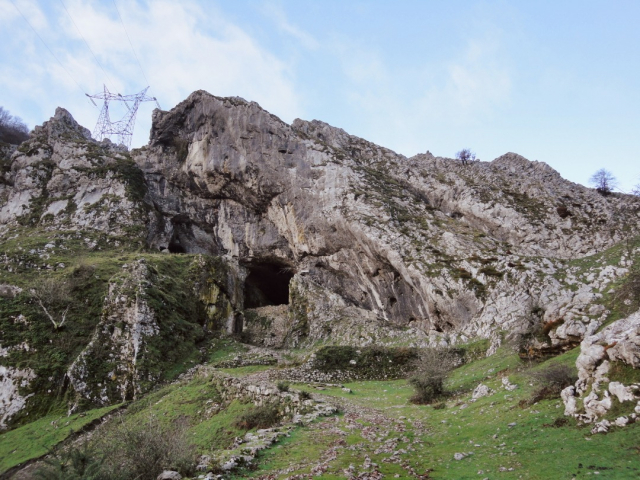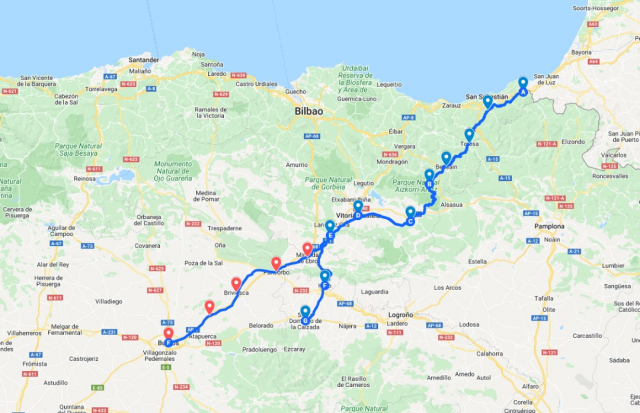Inland Basque Way - Stages and Map
To cross the enormous distance between Guipúzcoa and Álava, the Inland Basque Way, also known as the Bayona road, was formed.
- The origins of theInland Basque Way date back to Roman times.
- Why choose the Inland Basque Way to reach Santiago de Compostela?
- What to eat and where to sleep on the Inland Basque Way?
- All the stages of the Inland Basque Way
- Inland Basque Way through Santo Domingo de la Calzada
- Inland Basque Way through Burgos
If we decide to leave our footprints in the unforgettable experience offered by the Camino de Santiago, we have at our disposal multiple paths to get to kiss Compostelan lands. While it is true that some routes are more popular than others, the antiquity of the Jacobean phenomenon has opened a complex root of roads that allows us to travel them from virtually anywhere in the country.
The Camino del Norte can boast of being one of the most chosen routes to travel to Santiago de Compostela. And it is not for less, since it crosses the entire north of the peninsula next to the spectacular panoramic views provided by the Cantabrian Sea. It was once the route used by European kings during much of the Middle Ages, and today it is one of the best options to live intensely the true essence of the pilgrimage.
The origins of theInland Basque Way date back to Roman times.
The Northern Way of St. James runs through the Basque Country, Cantabria, Asturias and Galicia. However, from Irun you can discover a route enriched by its historical heritage and places worth visiting. To cross the enormous distance between Guipuzcoa and Alava, the Inland Basque Way was formed, also known by other names such as the San Adrian Tunnel Road or the Bayona Road.
It could be said that the Inland Basque Way is one of the oldest paths in the peninsula, since its origins date back to ancient Roman times. During the heyday of the pilgrimage, the devotees of the French town chose this road to find the tunnel of San Adrián and thus continue along the French Way. Thanks to this set of events, today you can enjoy small pieces of history on the Inland Basque Way that pay homage to Santiago.
Why choose the Inland Basque Way to reach Santiago de Compostela?
Pilgrims traveling along the Bayonne route will discover each of the reasons why the Basque Country arouses so much curiosity around the world. In addition to numerous legends, mythological beings, history and a beautiful mountainous landscape that remains engraved in the memory, we must also add the extensive Basque culture and gastronomy.
The Inland Basque Way is enveloped by a magic like in few places in the peninsula. You can feel the uniqueness of the north throughout the route. It crosses the entire Sierra de Aizkorri through the tunnel of San Adrián to pass to the other side. Once the pilgrims cross this singular path, they will be surprised by the natural contrast.
What to eat and where to sleep on the Inland Basque Way?
On this route we can find many hostels for pilgrims in all stages, from Irun to Santo Domingo and Burgos, so they will have no problem finding a place to spend the night. In addition to this, we can also find other accommodation options, such as hotels or rural houses.
The exquisite gastronomy of the Basque Country is recognized worldwide, therefore, no pilgrim should miss the opportunity to try many of the typical dishes such as cod Biscayan style or hake Basque style.
All the stages of the Inland Basque Way
The Bayonne route or the Basque Way of the Interior starts in Irún and divides at Puebla de Arganzón. From this point, pilgrims can continue their journey through Santo Domingo de la Calzada or through Burgos to finally join the French Way. The kilometers and stages that separate Irún from Santiago de Compostela will depend on the route chosen.
- Stage 1: Irún - Hernani (24.9 km)
- Stage 2: Hernani - Tolosa (19.2 km)
- Stage 3: Tolosa - Beasain (18.6 km)
- Stage 4: Beasain - Zegama (17 km)
- Stage 5: Zegama - Salvatierra/Agurain (21.9 km)
- Stage 6: Salvatierra/Agurain - Vitoria/Gasteiz (27.8 km)
- Stage 7: Vitoria/Gasteiz - La Puebla de Arganzón (18.8 km)
Inland Basque Way through Santo Domingo de la Calzada
- Stage 8: La Puebla de Arganzón - Haro (30.1 km)
- Stage 9: Haro - Santo Domingo de la Calzada (20.7 km)
Inland Basque Way through Burgos
- Stage 8: La Puebla de Arganzón - Miranda de Ebro (17.1 km)
- Stage 9: Miranda de Ebro - Pancorbo (16.4 km)
- Stage 10: Pancorbo - Briviesca (23.2 km)
- Stage 11: Briviesca - Monasterio de Rodilla (19.2 km)
- Stage 12: Monasterio de Rodilla - Burgos (28 km)
Routes
Blog
 ¿Vas a hacer el camino de Santiago? Cuida tus pies antes y después
¿Vas a hacer el camino de Santiago? Cuida tus pies antes y después
 5 razones por las que contratar un seguro de viajes
5 razones por las que contratar un seguro de viajes
 Formas de hacer un logotipo
Formas de hacer un logotipo
 La importancia del registro de llamadas durante tu viaje por el Camino de Santiago
La importancia del registro de llamadas durante tu viaje por el Camino de Santiago
Information
Points of interest
Cities & Towns | Hostels | Lodgings | Restaurants | Saddlery | Doctors | Points of interest | Bikes workshop
Contact us | Privacy policy | Cookies policy | | Terms of use | Authorship | Web Map | Consentimiento
© Copyright LA VOZ DE GALICIA S.A. Polígono de Sabón, Arteixo, A CORUÑA (ESPAÑA) Inscrita en el Registro Mercantil de A Coruña en el Tomo 2438 del Archivo, Sección General, a los folios 91 y siguientes, hoja C-2141. CIF: A-15000649

